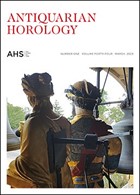Two precision clocks by Nicholson featured in Antiquarian Horology Journal
April 23rd, 2023share this

One of the most enjoyable things about researching Nicholson’s numerous interests and activities is the way that it has brought me into contact with so many people that I might never encountered otherwise. Experts in a variety of fields have been unbelievably kind and generous in sparing their time and energy to help me understand what Nicholson was up to and the context of his work at the time. One thing they all share has been a keenness to see that William Nicholson and his achievements should be better known and appreciated.
The most recent example is horological guru Jonathan Betts - Curator Emeritus at the Royal Observatory (National Maritime Museum), Greenwich, a horological scholar and author, and an expert on the first marine timekeepers created by John Harrison in the middle of the 18th century.
Jonathan is also the librarian to the Antiquarian Horological Society, and recently authored two articles about Nicholson which have been published in the society’s journal Antiquarian Horology, Vol 44, March 2023:
- ‘Two precision clocks by William Nicholson’; and
- ‘Notes from the Librarian: William Nicholson – so much more than a journalist.’
Forty years previously, in 1983, Betts had first encountered Nicholson (in regard to his comments on Explanations of Time-keepers Constructed by Mr Thomas Earnshaw and the late Mr John Arnold in 1806) and then in 2013 he acquired a collection of horological papers which had been published by Nicholson. A little while after this, I must have popped into his in-box after finding his paper on Nicholson’s good friend John Hyacinth Magellan (1722-1790).
In this article, Jonathan Betts forensically examines the two clocks which have been signed by Nicholson, although – as we know that Nicholson employed instrument-makers – ‘it seems very likely that Nicholson oversaw the clock’s construction to his specification’ rather than having any ‘hands-on’ involvement,
Nicholson’s table regulator clock lives at the British Museum (and was highlighted in an earlier blog). Betts describes the design and combination of features in the movement of this clock as “unique” and “evidently designed so that the technical features can be exposed and appreciated – very much in line with Nicholson’s desire to disseminate technical information”.
The second clock - featuring for the first time in public in the AHS Journal - is described as a ‘miniature gimballed regulator” with parts dated 1805 and 1806, and as “more elegant” and “even more exposed and ‘on show’”.
Unfortunately, Betts describes how this design had a ‘significant failing in the proportions of the dead-beat escapement’ which can lead to a stopping or bottoming, although this may have been prevented by the gimbal arrangement in the design.
A gimbal is a pivoted support that permits rotation of an object about an axis (for example, like a stabiliser on a hand-held camera), and it seems that this clock was ‘almost certainly mounted on a tripod and was thus intended to be used in a ‘portable’ environment’ for example, at sea or when surveying.
Could Nicholson have designed this for use this onsite at the West Middlesex Waterworks in late 1806?
To purchase Antiquarian Horology Volume 43
If you are interested in horology and the technical details of these two clocks, then it is possible to purchase a single issue of Antiquarian Horology Volume 43 via the AHS website Shop for just £8.50 plus P&P.

#41
21stC readers of Nicholson's Journal
Can you shed light on
Mr Nicholson’s life?
Propose a guest blog

The Life of William Nicholson, 1753–1815
A Memoir of Enlightenment, Commerce, Politics, Arts and Science
Edited by Sue Durrell and with an afterword by Professor Frank James
£13.99
Order from Peter Owen Publishers
Order